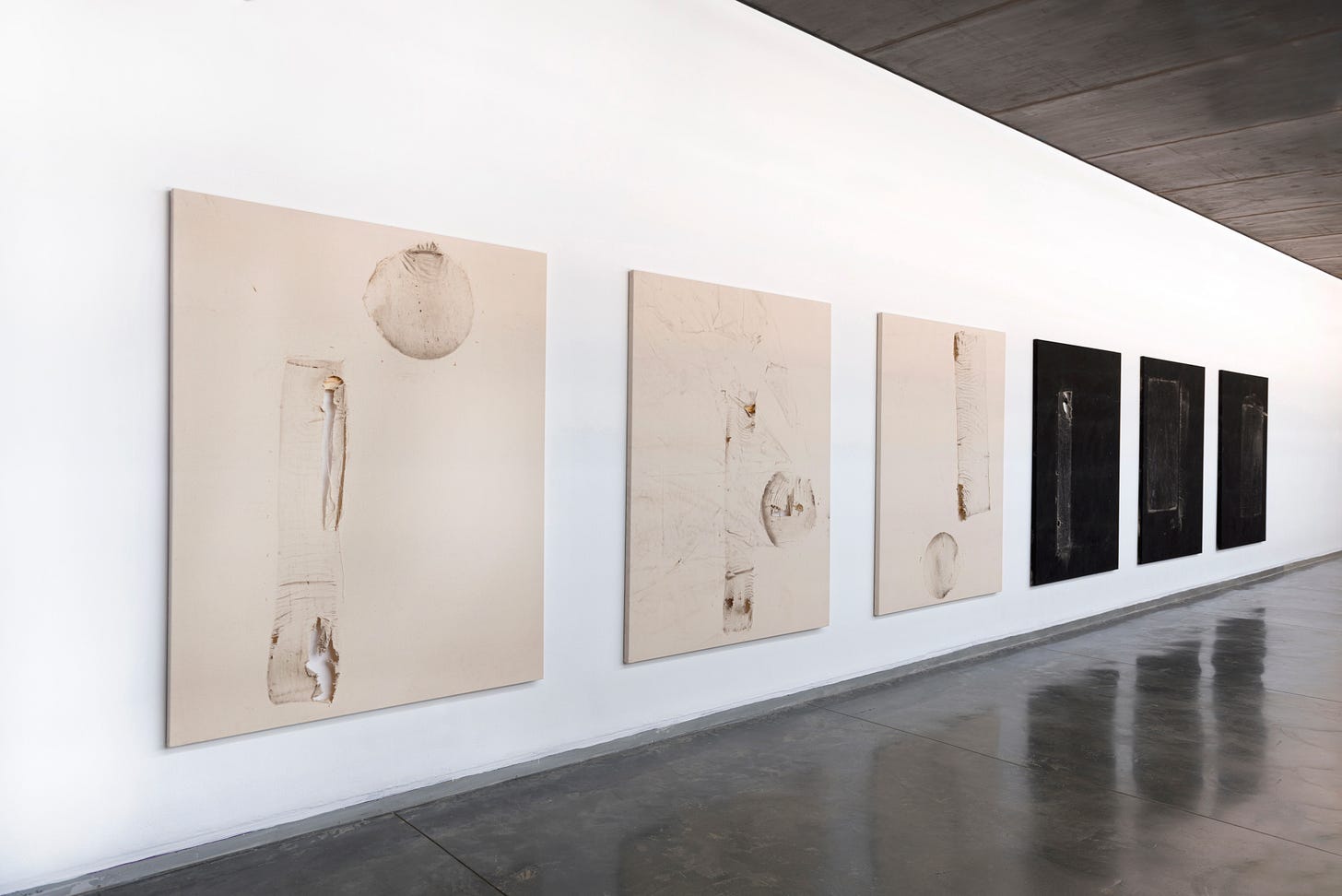Vicent Machí Makes Poetic Paintings From Dragging Canvas in the Street
The thing that caught my attention about Vicent Machí’s art was a video on Instagram. In the clip, Vicent drags what looks like a canvas attached to a piece of wood down the street. He’s in an abandoned place, perhaps on the edge of town, no one else around, just Vicent dragging his curious contraption through the landscape.
I had been following Vicent’s work for a while, already drawn to his minimal use of colour, sparse compositions and a soft visual sense that I think we have in common as artists. But seeing the clip of how he made these beautifully subtle works, my curiosity was piqued. I noticed how his action of dragging the fabric was creating a ghostly impression that felt like a wonderfully improvised brush mark. I was excited by this experimental approach to mark-making, but also the idea of getting out of the studio and having a tangible relationship with the environment.
I got the sense that Vicent’s paintings were poetic, rooted in his walks and his relationship to a specific place. There was much more to discover about his work so I dropped Vicent - who’s based in Valencia, Spain - a DM on Instagram and he was up for speaking to me.
Hey Vicent. Firstly, can you tell me about your recent show in Valencia? The work looks very ambitious!
So I have two exhibitions in Valencia at the moment: El camí de l’aigua (The path of water) at Galería Vangar, and La memòria del terra (The ground memory) at the MuVIM Museum. These two shows are part of two different but parallel series that I started two years ago.
I was intrigued to see a video of you dragging a canvas down the street. Can you describe your process and how you use canvas in this way?
This performance is part of La memòria del terra, it’s a series in which I attach raw cotton fabrics and others covered in black to two different wooden artefacts, one with a rectangular base and another smaller one with a circular shape.
I use a rope and I drag these artefacts along the pavement of the street, and it’s this action that ends up “painting” rectangles and circles in the works.
What do you love about the half-destroyed / worn fabrics that you bring back into the studio?
I wanted to highlight the rawness of the images, both in the canvases - with a careless, dirty and rough production - and in the video that shows the performance in a partially unpopulated rural environment.
In the studio, the only process in this series is to paint some canvases in black and after dragging them, tie them to the frame. Actually, the process is carried out in the street, in the urban environment, which I think of as the protagonist of this project.
I’m really attracted to art practices like yours, which involve getting out of the studio, so I love that you go out into the world to make work. Is that connection to the environment important to you?
It was very important to get out of the studio in this particular series, because the environment I show in the video that records the performance is actually the protagonist.
It’s my hometown of Gavarda, near Valencia. This town was affected by a flood in 1982; the “Pantanada de Tous”. After this catastrophe the town began to lose many residents and today it’s becoming a ghost town with very few inhabitants. This is what I really want to show in the project. The few inhabitants that remain take care of the public space and the authorities have forgotten us.
There’s also a quietness about your work that feels poetic. Do you think of the work as calming, and is it therapeutic to make?
Yes, although the work is hard and dirty in its process and details, the works always have a harmonious aesthetic, with neutral and balanced colours and shapes. Actually, I look for a primary and simple language so that the video, the performance, the territory about which the project speaks, take centre stage.
I do think it’s a relaxing work in its appearance, but the viewer can also hopefully see that it has crudeness and violence in its processes, which is what I want to speak about.
You’ve done a few shows in Valencia now. What’s the art scene like there?
It’s a very local scene, which has its good and bad points. It’s very pleasant, but it seems that it is difficult to go further here as an artist. Valencia has been growing for years as a Spanish artistic leading city, marking its own powerful line of work. But in Spain and many other countries, centralism and the importance given to the capital, Madrid, means that the work done by other cities is lost.
What’s the most important thing that you would hope people take away from seeing your work?
I appreciate when people make a connection with my work. Many times the viewer observes and highlights things that the artist and the process do inherently - for my work, that is enriching.
Follow Vicent on Instagram: @vicentmachi________
Things on Our Radar This Week
Vicent’s two shows, El camí de l’aigua at Galería Vangar, and La memòria del terra at the MuVIM Museum
An old but interesting article on the act of walking in art that feels fitting this week
Daisy Paris will have her third solo show at Sim Smith in Autumn (8 Oct – 9 Nov)
Plaster mag’s case against art fairs, which are famously “expensive, exhausting and ecologically harmful”
Betsy Bradley and Eva Dixon are among the artists in a forthcoming group show at Haricot Gallery
Thanks for reading, see you next time!Oliver & Kezia xx
Palette Talk is free and we hope to grow with your support. If you’ve enjoyed reading, drop us a donation via PayPal…









